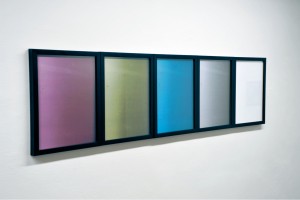Copyshop galaxy
 die Copyshop-Galaxie die Copyshop-Galaxie Immer wieder musste ich im Jahr 2010 für diverse Einreichungen Portfolios ausdrucken. Funktionierte mein Drucker gerade nicht, so blieb mir nichts anderes übrig, als in den mir verhaßten „REPA-copy-shop“ zu gehen. Dort hatte ich oft mit der Falschfarbigkeit und der Farbstichigkeit der Ausdrucke zu kämpfen. Bei den Geräten handelte es sich um digitale Laserkopier- und Druckgeräte des Herstellers Xerox. War ein Ausdruck zu rot- gelb- oder blaustichig, so konnte man mittels des Menüdisplays den entsprechenden Farbton nach oben und unten regeln. Durch diese Auseinandersetzung mit den Geräten kam ich auf die Idee doch einfach das leere Auflagenglas zu kopieren, 5 mal, wobei ich bei jedem Durchgang einen jeweils anderen Farbton auf maximal trimmte und die restlichen Töne auf das Äußerste minimierte. So erhielt ich monochrome Farbausdrucke, die quasi die das Eigenfarbrauschen des Gerätes abbilden, (und natürlich auch etwaige Fingerabdrucke auf dem Auflagenglas). Hinsichtlich der auf den monochromen Ausdrucken abgebildeten Fingerabdrucken des Auflagenglases entstand durch die Rahmung der Drucke hinter Glas eine interessante Doppelung: Als ich die Drucke am Stand der Galerie Alnöder auf einer Kunstmesse präsentierte, versuchte die Galeristin dauernd und von Neuem, die Fingerabdrücke vom Glas der Rahmen wegzupolieren – bis sie entdeckte, dass es sich nicht um Abdrücke auf dem Rahmenglas, sondern um Abbilder von Fingerabrucken auf den monochromen Drucken handelte –
//
In 2010, I often went to the so-called „REPA“-copyshops to print out my proposals and portfolios. Most of the time I had to struggle with the bad quality of the prints, it was extremely difficult to set the colour-values on their right levels. But nevertheless, with this machines it was possible to set the grades of the different coulours manually. So, if the red, blue or yellow tonality of the printed result was to weak or strong, I could set and adapt the coulour-intensity manually. Dealing with this problems, following idea popped up: I started to make copies of the empty glass, with each print I set one of te colour tones on maximum and the rest on the very minimum. So the machine’s system itself became visualized and also another interesting aspect of the prints appeared: Due to the print’s framing behind glass, it seemed that the fingerprints depicted on the print – copies from the fingerprints on the machine’s glass. I showed the prints on an artfair with Altnöder gallery and after the work’s installation on the walls, the gallerist repeatedly tried to swipe away the workers‘ fingerprints from the surfaces of the frames‘ glasses.
|